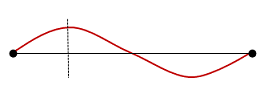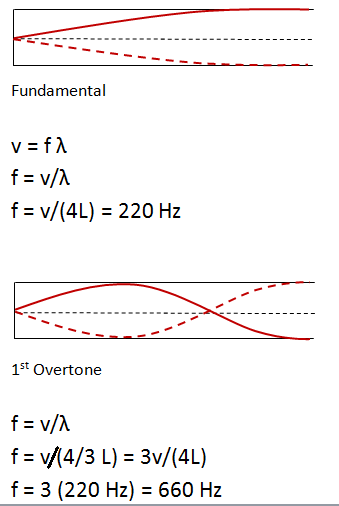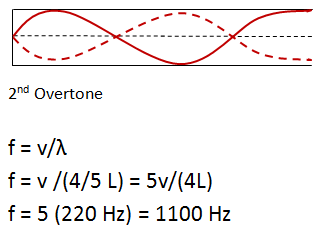A particular musical instrument is found to have only odd harmonics. If the instrument plays a low A (220 Hz), what are the frequencies of the first two overtones? What resonates to provide the sound that is amplified in this instrument?
-
In this problem, you are directly told to consider overtones of vibration. Overtones are standing wave patterns that result from the superposition of identical waves in the same place at the same time. Therefore, this is a 1-dimensional standing wave problem. Regardless of the details of a question, always begin with the key physics of the situation.
Overtones are the higher order normal modes of vibration of an object; each normal mode corresponds to a natural frequency of vibration. The first (simplest) normal mode is called the fundamental and in instruments its corresponding frequency determines the pitch of the note. The more complicated normal modes determine the quality of the sound and are called overtones. Overtones are numbered beginning with 1, and so the full set of normal modes is the fundamental, the first overtone, the second overtone, etc. This terminology holds regardless of the relationship between frequencies. If the overtones are also integer multiples of the fundamental frequency, they are also called harmonics. Harmonics are numbered according to the integer multiplier, so the fundamental frequency is also the first harmonic.
The fundamental frequency is the frequency of the simplest normal mode of vibration of an object, and corresponds to what our brain interprets as pitch (or the note being played.) This is always the lowest frequency of the vibration.
Identical waves are waves of the same kind (waves in a string, sound waves, etc.) with the same wavelength and amplitude. In this case, sound waves in the pipe are reflected at the ends. As a result, identical waves are traveling back and forth in the pipe.
The sound waves travel in a single direction along the pipe, so this is a 1-d standing wave. A two-dimensional standing wave would be waves in and out of a 2-d surface, such as standing waves on water. Note that for standing waves, you are interested in the wave in the instrument generating the sound and not the wave outside the instrument that propogates to your ear.
The actual vibration of an object is the sum of all of the normal modes of vibration that are present. To superpose waves, you add the amplitude of all oscillations present at each location.
Isn't this just a definition problem? Do I have to go to all this work?
If you recognize this as a definition of harmonics problem, and know that the frequencies will be 1, 3 and 5 times the fundamental frequency, that is fantastic. You absolutely do not need to go through all of the steps presented here. That said, these steps model a basic procedure that you can use in other problems that are not as obvious to you.

Even though you are asked for the overtones, always begin with a picture of the fundamental oscillation. The fundamental oscillation is the simplest wave pattern that meets the boundary conditions. In this case, you are not given direct information about the boundary conditions. Instead, you are told that only odd harmonics are present. If you have experience with other problems, you will recognize this to mean that the instrument is a closed pipe. The boundary conditions at the two ends are then different--the closed end is a position node (or pressure anti-node) and the open end is a position anti-node (or a pressure node.) The simplest pattern that accomplishes this is one fourth of a wavelength
.
Once you have the fundamental oscillation, you can build the overtones in order just by making them increasingly complicated. Each addition of a node takes you to a higher order overtone. Note that as soon as you recognized that only odd harmonics means you have a closed pipe, you have answered the second question.
Why did you talk about adding nodes to draw the overtones? My instructor taught me to add loops.
This is the same thing. Every time you add a node into the drawing, you introduce an additional half wavelength.
You talk about wavelengths and half wavelengths, but I don't see it. I see loops in the drawings instead.
Remember that the air in the pipe is continually vibrating back and forth--sound is a longitudinal wave. The drawings of standing waves are really graphs of either pressure or motion. I chose to graph the motion of molecules at each point. (The x-axis shows the equilibrium location of a molecule and the y-axis shows its x-displacement about that point.) To make the graph, I show the two extremes of the motion, so that the solid lines on the drawing represent the maximum displacement of a moleculde as it stops moving in one direction and the dotted line represents its displacement as it stops in the other direction. Two loops (just look at the solid line) show a complete cycle of molecular oscillation. Note that half of a loop corresponds to one quarter of a wavelength.

My book shows anti-noes at the closed end and nodes at the open end. Why did you draw the opposite?
At the closed end of the pipe, the molecules are constrained to remain in place. However, as the molecules next to them move they put the largest pressure variations on that location. At the open end of the pipe, the pressure is fixed (air pressure) and for that to be true the molecules have the greatest range of motion. I graphed the motion of the molecules; your book graphed pressure variations. Either works fine--in both cases, we find the fundamental frequency is one fourth of a wavelength.
In this case, you are not told what instrument is being played but you are told that only odd harmonics are present. So you need to apply your conceptual knowledge or experience with other examples and problems. Both open pipes and strings have both even and odd harmonics, but pipes that are closed on one end only have odd harmonics. You need that as prior knowledge to approach the problem in one step. If you don't have that prior understanding, you can solve for all three cases (see Sound of a Piano as an example where all harmonics are presesnt) until you reach the point where you see which examples have all harmonics and which have odd harmonics only.
In an acoustic instrument, the vibrations of the air column or string are picked up by the body of the instrument itself. For example, the bell on a brass instrument, the body of a guitar, or the sounding board of a piano all amplify the sound and select out some overtones more than others. This gives rise to the unique sound of each instrument.
Standing waves in a string or air column resonate--they are the waves that are amplified rather than fading out quickly.
Boundary conditions are just the conditions at the end (or edges) of the object. If we know what must be true at the edges, we know the only allowed wave patterns are those that meet those conditions.
The easiest way to make sure you have not skipped any overtones is to count the nodes. Keep the boundary conditions fixed and look at increasingly complicated patterns of vibration that meet those boundary conditions. The only way to keep the boundary conditions fixed is to add half-wavelengths (because they return you to the same end condition), or, in other words, to add nodes.
At the closed end of the pipe, the molecules are constrained to remain in place. At the open end of the pipe, the pressure is fixed (air pressure) and for that to be true the molecules have the greatest range of motion. Therefore, the closed end of the pipe is a position node and the open end is a position anti-node.
At the closed end of the pipe, the molecules are constrained to remain in place. However, as the molecules next to them move they put the largest pressure variations on that location so the closed end of the pipe is a pressure anti-node. At the open end of the pipe, the pressure is fixed (air pressure) and so it is a pressure node. Note that I chose to graph position rather than pressure, but either works fine.
If you go from one node to the closest anti-node, you have a quarter wavelength. One node to the next gives half a wavelength. A full wavelength has an additional node in the middle.

Standing wave pictures give a picture of, and a way to measure, the the wavelength of the oscillation of interest. In this case, you are asked to consider the frequencies associated with the wavelengths. Wavelength and frequency are always related by the wave equation:
v = f λ
How do you know the wave in the air column moves with the speed of sound?
The wave in a wind or brass instrument is a longitudinal wave in air. In other words, it is a sound wave.
This isn't the equation my book uses for standing waves. My book gives equations for f in terms of length.
Those equations are partially-solved versions of the wave equation, and each set of equations is specific to a particular case. If you always start wtih the wave equation, you only need one equation and all problems are worked in the same way regardless of boundary conditions.
The wave equation is just a re-write of the defintion of velocity (change in displacement over time) for the specific case of waves. By definition, it takes one period for the wave to travel one wavelength.


We now know the frequencies of the first two overtones, and we previously determined the instrument is an open pipe. No further solution is necessary
I don't know the length of the pipe. Don't I need to know the wavelength of the wave in order to solve for the frequency?
In this case, you do know the fundamental frequency of the wave. Any time you are comparing cases, it is likely that you can solve the problem with ratios (and the unknowns will cancel out) or by solving the known case for a group of variables together as I do here. If you are not sure if this approach will work, as a general rule of thumb you don't need to know all variables if your relation involves multiplication and if you know information about one case.
Can I use the information about fundamental frequency to solve for the length of the pipe?
Although that is not the most efficient approach (see above Query Question), you can often use a known case to solve for unknown variables that appear in the second case. Ratio reasoning is very powerful, and so although you could do the extra step and work this problem through length, it is good to learn to solve it by ratios insetad.
The wave in the pipe is a sound wave, and so v in this equation refers to the speed of sound in air. However, you can solve the problem using ratios and so don't actually need to know the value.
In this case, one fourth of a wavelength fits between the node at one end of the pipe and the anti-node at the other. The length of the pipe is equal to 1/4 of a wavelength, so the wavelength is four times the length of the pipe.

In this case, three fourths of a wavelength fills the pipe. 3λ/4 = L, so λ = 4L/3.
In this case, one and a fourth wavelengths (five fourths of a wavelength) fill the pipe. 5λ/4 = L, so λ = 4L/5.
To divide by a fraction, invert and multiply. 1/(4/3) = 1 x (3/4)
To divide by a fraction, invert and multiply. 1/(4/5) = 1 x (5/4)
In this problem, the word "overtones" should flag that you want to examine standing waves, even if you aren't yet comfortable recognizing the relationship between standing waves, resonance, and musical instruments. All you need in order to understand 1-dimensional standing waves is a picture of the waves and the wave equation. In this case, you were not told whether the standing waves were in a string, an open pipe, or a closed pipe. You had instead the information that only odd harmonics were present, which constrains the boundary conditions and leads you to the realization that the instrument is a closed pipe.
That said, make sure to relate your answers to your musical knowledge. You know that overtones are higher frequencies than the fundamental and that harmonics are integer multiples of the fundamental.
The frequencies that you hear in a musical instrument are those that resonate--that correspond to strong waves in the string or air column and do not cancel out. Resonant frequencies are associated with normal modes of oscillation.
Are overtones the same as harmonics?
Overtones and harmonics represent the same basic idea but are numbered differently. In both cases, you are looking at the normal modes of vibration of the instrument; each normal mode corresponds to a natural frequency of vibration. The first (simplest) normal mode is called the fundamental and its corresponding frequency determines the pitch of the note. The more complicated normal modes determine the quality of the sound and are called overtones. Overtones are numbered beginning with 1, and so the full set of normal modes is the fundamental, the first overtone, the second overtone, etc. This terminology holds regardless of the relationship between frequencies.
Naming normal modes as harmonics, on the other hand, is based on frequency. If the frequency of a normal mode is an integer multiple of the fundamental frequency, then that normal mode is also called a harmonic. Harmonics are determined by the integer multiplier. Since the frequency of the first normal mode is 1 x the fundamental frequency, the first normal mode is also the first harmonic. Not all harmonics are present in all objects. For example, in this case you are told that only odd harmonics (n = 1, 3, 5, etc.) are present.
Is this a string instrument or a wind or brass instrument?
In this case, you are not told what instrument is being played but you are told that only odd harmonics are present. So you need to apply your conceptual knowledge or experience with other examples and problems. Both open pipes and strings have both even and odd harmonics, but pipes that are closed on one end only have odd harmonics. You need that as prior knowledge to approach the problem in one step. If you don't have that prior understanding, you can solve for all three cases (see Sound of a Piano as an example where all harmonics are presesnt) until you reach the point where you see which examples have all harmonics and which have odd harmonics only.
